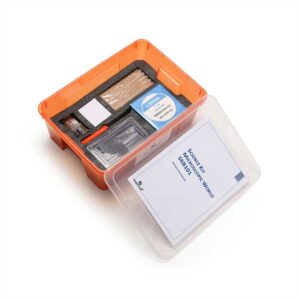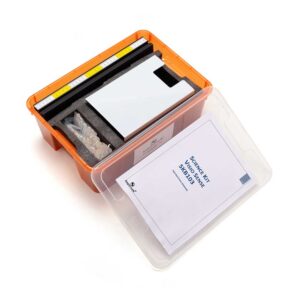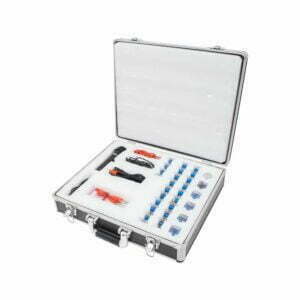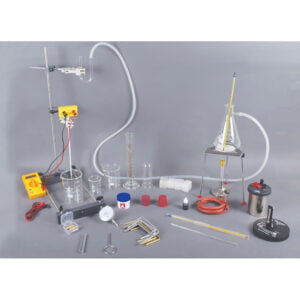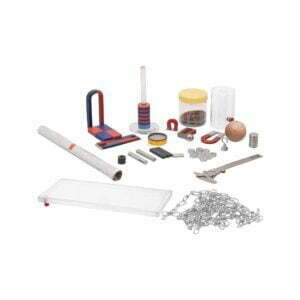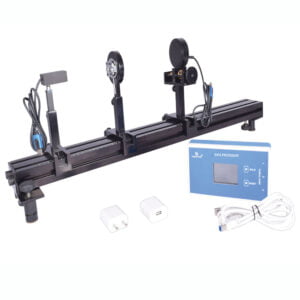-
Elementa Kits
Microscopic World
Unlocking the Secrets of the Microscopic World!
Step into the world of tiny wonders with this kit. This comprehensive kit is designed for students, educators, and young explorers who want to explore the microscopic details of everyday objects. From fish scales to plant cells, this kit brings science to life through hands-on experiments. All equipment is safely housed in a secure, lidded plastic drawer perfectly organized for effortless storage and quick access whenever you need it.
Key Features:
- Step-by-Step Instructions: Clear, easy-to-follow instructions for each experiment, suitable for beginners.
- Versatile Experiments: Explore a variety of biological specimens, including fish scales, onion cells, moss, and insect parts.
Experiments Included:
1. Fish Scales Examination: Observe and analyze the overlapping structure of fish scales.
2. Onion Cell Study: Explore the cell structure of an onion under a microscope.
3. Plant Stem Cross-Section: Learn about vascular tissues and cellular arrangement.
4. Moss Leaf Observation: Identify chloroplast and cellular structure in moss leaves.
5. Insect Leg Anatomy: Study the specialized leg structure of bees.
6. Insect Mouth Parts: Understand the specialized feeding structures of bees.
7. Stinging Nettle Hair Study: Discover the structure and function of nettle hairs.Includes student sheets for guided exploration and teacher sheets for detailed explanations.
Supplementary Material Needed:
- Laboratory Monocular Microscope (BLM33C)
SKB101 -
Elementa Kits
Visio Sense
Advancing Knowledge and Enlightening Minds Through Every Experiment!
Step into the fascinating world of optics with our Visio Sense Kit – a hands on educational journey that unveils the secrets of light and vision. Whether in a classroom or for self-learning, this kit makes complex optical concepts easy to understand through fun, interactive experiments.
This kit is securely stored in a transparent plastic drawer with a fitted lid for easy organization and protection.
Engaging Experiments Include:
- Light Path Exploration: See how light converges with a convex lens or diverges with a concave lens.
- Understanding Light Dispersion: Watch white light split into a spectrum of colors, revealing the beauty of light dispersion.
- Build a Dutch Telescope: Assemble your own telescope and learn how lenses create magnified images.
- Eye Structure Investigation: Study a model of the human eye, learn its parts, and understand common eye defects like myopia and hypermetropia.
- Shadow Formation: Explore the difference between deep shadow (umbra) and half shadow (penumbra) through practical activities.
- Light Refraction & Reflection Studies: Observe light bending through a semi-circular medium and study reflection with a plane mirror.
- Image Projection with Lenses: Use a convergent lens to project clear images on a surface, understanding how images are formed.
Comes with a detailed instruction manual, making learning smooth and enjoyable for students and teachers alike.
Supplementary Material Needed:
Power Supply (PH61022D/2)
Output Voltage- 0-15V DC
Output Current- 2ASKB103 -
Elementa Kits
Basic Optics & Light
Unlock the secrets of light and optics with this exciting kit!
From fundamental principles to advanced optical phenomena, this kit offers a complete journey through the world of light. Dive into guided, hands-on experiments that illuminate complex concepts with clarity and excitement. This kit enables students to explore how light propagates, reflects, refracts, and disperses using precision optical components. Neatly organized in a sturdy storage box with a custom foam inlay, this kit keeps all components secure and easy to handle. Each piece fits perfectly into its designated recess, ensuring safe storage and quick setup for every experiment.
Dive Into the Wonders of Optics with These Captivating Experiments:
- Trace the path of light rays and explore how a deviating prism bends them.
- Discover the inner workings and construction of an astronomical telescope.
- Unveil the magic of white light splitting into its spectrum of primary colors through dispersion.
- Understand the fundamentals behind the imaging equation.
- Observe how light travels in straight lines, demonstrating rectilinear propagation.
- Study how rays interact with different mirrors—planar, convex, and concave.
- Experience how light behaves as it passes from air into acrylic glass, revealing fascinating changes in direction.
A Comprehensive manual designed for both teachers and students accompanies this kit, guiding every step with clear instructions and insightful explanations.
Supplementary Material Needed:
Power Supply (PH61022D/2)
Output Voltage- 0-15V DC
Output Current- 2ASKB109 -
Elementa Kits
Electricity Basics
Empowering Hands-on Learning!
Unlock the wonders of electricity with our comprehensive kit. Designed for students and educators, this kit provides a hands-on approach to exploring fundamental principles of electricity and magnetism. From simple circuits to complex experiments, this kit is your gateway to practical understanding. The equipment is stored in a sturdy box with a foam inlay, featuring custom-shaped slots to keep each piece secure, complete with a protective lid for safe storage.
Discover the World of Electricity with Exciting Experiments:
- Lines of Force of a Magnet
- Magnetic Effect of Electric Current
- Magnetic Field of a Coil
- Frictional Electricity
- The Compass – Understanding Magnetism
- Force Acting Between Charges
- Action of an Electroscope
- Electric Induction on an Electroscope
- Conductivity of Liquids
- Resistance of a Liquid
- Electroplating
- Simple Electric Circuit
- Measuring Currents and Voltages
- Ohm’s Law
- Resistance of a Wire
- The Potentiometer
- Series and Parallel Connection
- Power and Energy
- The Diode – Basics of Semiconductors
Comes with an easy-to-follow manual designed to support smooth and engaging learning for teachers and students.
Supplementary Material Needed:
Power Supply (PH61010/5)
Output Voltage- 2 to 12V AC in 2V steps. Full wave rectification
2 to 12V DC in 2V steps.
Output Current- 5ASKB111 -
Elementa Kits
Thermal And Hydro
Explore the Fundamentals of Heat and Hydrodynamics!
This kit is an advanced educational toolkit comprising curriculum-aligned experiments in thermodynamics and hydrostatics. Designed for interactive learning in school laboratories, this kit helps students deeply understand heat flow, water behavior, air expansion, buoyancy, and much more.
All equipment is safely housed in a secure, lidded plastic drawer perfectly organized for effortless storage and quick access whenever you need it.Key Experiments Included:
- Bimetallic Strip Behavior
- Calibration of a Thermometer
- Evaporation and Condensation
- Heat Flow in Air
- Heat Flow in Water
- Heat Radiation
- Mixture Temperature
- Volume Expansion of Air
- Volume Expansion of Water
- Heat Flow Through Air
- Temperature Measurement
- Sinking and Floating
- Hydrostatic Pressure
- Connected Vessels (Communicating Vessels)
- Forces Acting on Bodies in Water
Comes with an easy-to-follow manual designed to support smooth and engaging learning for teachers and students.
SKB113 -
Elementa Kits
Introductory Physics
Uncover the secrets of science with this exciting kit!
Explore the wonders of physics with this engaging kit! Dive into hands-on experiments covering mechanics, density, buoyancy, and measurement. Perfect for sparking curiosity, it transforms complex concepts into fun, interactive learning experiences helping students build critical thinking skills while exploring the science that shapes our world.
All components are thoughtfully arranged in a durable plastic storage box, ensuring effortless organization. This smart design guarantees a hassle-free setup and enables consistent, repeatable experiments every time.
Dive into discovery with a series of captivating experiments!
- Explore Archimedes’ Principle through hands-on activities. See how objects float or sink and uncover the secrets of buoyancy!
- Measure displaced water and understand gravitational force. And see how much water is pushed away when objects dive in.
- Determine mass and calculate density with precision.
- Discover volume using both direct and indirect methods.
- Compare various measurement techniques for accuracy.
A comprehensive manual designed for both teachers and students accompanies this kit, guiding every step with clear instructions and insightful explanations
Supplementary Material Needed:
Digital Balance
Least count: 0.01g
Maximum Capacity: 200gSKB117 -
Science Kits
Electronics Kit 1
Electronics Kit 1 includes materials for over 10 activities on electronics-based topics. The kit comes in a heavy-duty carry-case for ease of storage. A full manual with detailed activities for both the teacher and the student is included.
Experiments include:
- Forward Bias Diode,
- Half-Wave Rectifier,
- Zener Diode,
- Transistor as a Switch,
- Measuring Gain with a PNP Power Transistor,
- Infrared Diode and Phototransistor,
- Light Dependent Resistor,
- Temperature Dependent Resistors,
- Silicon Controlled Rectifier,
- TRIAC,
- Unijunction Transistor.
SKEL01 -
Science Kits
Electronics Kit 2
Electronics Kit 2 is a supplemental kit to Electronics Kit 1. It includes materials for 5 activities on advanced electronics-based topics. The kit comes in a heavy-duty carry-case for ease of storage. A full manual with detailed activities for both the teacher and the student is included.
Experiments topics include:
- Stable multivibrator,
- Full wave rectifier,
- Full wave rectifier with the capacitor,
- Push-pull amplifier,
- Two-stage audio amplifier,
- Two-stage audio amplifier.
SKEL02 -
Science Kits
Electrostatics Kit 1
Electrostatics Kit 1 includes materials for over 10 activities on electrostatic-based topics. The kit comes in a heavy-duty carry-case for ease of storage. A full manual with detailed activities for both the teacher and the student is included.
Experiments topics include:
- Electrostatics with rods and cloth,
- Charge distribution on an object,
- Types of charges,
- Comparing magnetic and electrostatic forces,
- Electroscope,
- Insulator versus conductor,
- Charging by induction and conduction,
- Electrophorus,
- Coulomb’s law,
- Charge inside a conductor,
- Faraday’s ice pail.
SKES01 -
Science Kits
Heat Kit 1
Heat Kit 1 includes materials for over 13 activities on thermodynamics-based topics. The kit comes in a heavy-duty carry-case for ease of storage. A full manual with detailed activities for both the teacher and the student is included.
Experiments include:
- Psychrometry,
- Newton’s law of cooling,
- Specific heat of metals,
- Specific heat of water,
- Expansion of water,
- Heat of fusion,
- Linear expansion of a solid,
- Phase transitions and cooling curves,
- Heat conduction in a rod,
- Convective heat transfer,
- Pulse glass,
- Expansion of a gas,
- Expansion of a liquid,
- Thermocouple,
- Thermostat.
SKHE01 -
Science Kits
Mechanics Kit 1
Mechanics Kit 1 includes components for 18 activities on mechanics-based topics. The kit comes in a heavy-duty carry-case for ease of storage. A full manual with detailed activities for both the teacher and the student is included.
Experiments include:
- Pendulum- simple harmonic motion,
- The constant motion of a cart,
- Constant acceleration of a cart,
- Free fall,
- Inertia,
- Newton’s second law,
- Newton’s third law,
- Relationship between weight and mass,
- Pulleys with a spring,
- Vertical force table and vector addition,
- Pulley mechanical advantage,
- Lever,
- Atwood machine,
- The mechanical advantage of multiple pulley system,
- Incline plane,
- Friction,
- Hooke’s law with springs,
- Harmonic motion of a spring.
SKME01 -
Science Kits
Mechanics Kit 2
Mechanics Kit 2 includes materials for over 13 activities on fluid mechanics. The kit comes in a heavy-duty carry-case for ease of storage. A full manual with detailed activities for both the teacher and the student is included along with scientific background on each topic.
Experiments include:
- Water velocity from a spout,
- Mariotte’s bottle,
- Force pump,
- Boyle’s law with a syringe,
- Pascal’s ball,
- Communicating vessels,
- The density of an unknown liquid (U tube),
- Open tube manometer,
- Hare’s apparatus,
- Cartesian diver,
- Bernoulli’s principle,
- Viscosity (Ostwald viscometer),
- Capillary tubes.
SKME02 -
Science Kits
Magnetics Kit 1
Magnetics Kit 1 includes materials for 7 activities on magnetism-based topics. The kit comes in a heavy-duty carry-case for ease of storage. Simple to set up with all components easily accessible. A full manual with detailed activities for both the teacher and the student is included along with scientific background on each topic. Activities are designed to guide students to discover concepts but are styled so the instructor knows what equipment is needed for each activity.
Experiments include:
- Magnetic and non-magnetic objects,
- North and south poles,
- Earth’s magnetic field,
- Observing magnetic field lines,
- Interacting forces,
- Strength of magnets using ferromagnetic chains,
- Eddy currents.
SKMG01 -
Science Kits
Magnetics Kit 2
Magnetics Kit 2 is a supplemental kit to Magnetics Kit 1. It includes materials for 4 activities on advanced magnetism-based topics. The kit comes in a heavy-duty carry-case for ease of storage. A full manual with detailed activities for both the teacher and the student is included.
Experiments include:
- Diamagnetic, Paramagnetic, and Ferromagnetic Substances,
- Predicting Magnetic Field Lines,
- Current Induced Magnetic Fields,
- Magnetic Field Induced Current.
SKMG02 -
Syringe Filters
Syringe Filters Non-Sterile Single layered
Syringe filters are single-use, membrane-based filtration device. Supertek offers a wide Range of Syringe filters with different options of Membrane, Diameter and Pore size. Commonly used for fast and efficient filtration, this helps to purify the sample for analysis by removing the particulates from the solution.
Key Features
- High Flow Rates.
- 16 Channels for minimum back pressure.
- Absolute Microbial Retention.
- Wide Chemical Compatibility.
- Very low Extractable.
- Color coded (0.22 Pink), (0.45 Blue)
Applications of Syringe Filters
- Pharmaceuticals : Sterile filtration of drugs and reagents.
- Biotechnology : Preparation of cell culture media.
- Food & Beverages : Quality control of syrups and beverages.
- Environmental Agencies : Sample filtration for contaminant testing.
- Chemicals : Purification of solvents and reagents.
SNY02-N -
Syringe Filters
Syringe Filters Sterile Single layered
Syringe filters are single-use, membrane-based filtration device. Supertek offers a wide Range of Syringe filters with different options of Membrane, Diameter and Pore size. Commonly used for fast and efficient filtration, this helps to purify the sample for analysis by removing the particulates from the solution.
Key Features
- High Flow Rates.
- 16 Channels for minimum back pressure.
- Absolute Microbial Retention.
- Wide Chemical Compatibility.
- Very low Extractable.
- Color coded (0.22 Pink), (0.45 Blue)
Applications of Syringe Filters
- Pharmaceuticals : Sterile filtration of drugs and reagents.
- Biotechnology : Preparation of cell culture media.
- Food & Beverages : Quality control of syrups and beverages.
- Environmental Agencies : Sample filtration for contaminant testing.
- Chemicals : Purification of solvents and reagents.
SNY02-S -
Experiments
Size of Particle Experiment
OBJECTIVES
- To measure the width/thickness of the given samples by analyzing the diffraction pattern.
PRINCIPLE
The characteristics of light such as interference and diffraction can be understood when light is studied as a wave phenomenon. Interaction of waves with matter results in either transmission, reflection, absorption, or diffraction of the wave. When the size of the matter is comparable to the wavelength of the wave that it interacts with, a phenomenon called diffraction occurs. Diffraction of light due to particles is a function of the size of the particle and the wavelength of the light incident. It is possible to measure the size of a particle by studying the diffraction patterns created by it.
KEY FEATURES
- Easy Adjustable Laser: The multiple degrees of freedom on the laser mount helps in the effortless movement of the laser source. This helps in aligning the laser source with the sample quite easily.
- Laser Range Finder: The addition of a laser range finder allows the user to use any standard wall as a screen, increasing the distance between the screen and the sample. Thus, the diffraction pattern can be seen distinctly and thus increasing the accuracy of the readings.
- Multiple Samples can be Tested and Verified: The modular setup helps in measuring the diameters of different samples and other everyday objects as well.
WHAT YOU NEED
- OB1 Optical Bench Set 0.8m 1
- HA003 Laser Source Holder 1
- HA008 Grating Holder 1
- HA024 Screen Holder 1
- AC010 Laser Distance Meter 1
- AC018 Diffraction Grating 1
- AC012 Frame With Thread Type 1 1
- AC014 Frame With Thread Type 2 1
- AC016 Frame With Thread Type 3 1
Complete Equipment Set with Instruction Manual from catalogue.
SOP1-C -
Experiments
Single Slit Experiment
OBJECTIVES
- To find the wavelength of a given laser using the slit of known width.
- To find the slit width knowing the wavelength of light used.
- Proving the concept of the Heisenberg uncertainty principle.
PRINCIPLE
Diffraction is a phenomenon of bending of waves when it encounters obstacles or narrow opening. A basic setup to observe diffraction consists of a laser, a slit, screen placed at a distance. The wavefronts are partially obstructed by the slit. The intensity distribution of the diffraction pattern consists of a series of light and dark fringes with the intensity distribution symmetric along the central axis. The primary peak is called the central maxima. The corresponding peaks are called secondary, and tertiary maxima. This is studied using the single-slit experiment.
KEY FEATURES
- Precise Optical Alignment: The optical alignment of the components is attained by the optical bench, the set-up time is faster and experimentation is easy.
- Digital Lux Meter with Transverse Saddle: The digital Lux meter enables the measurement of light intensity. The transverse saddle helps in the fine movement of the Lux meter perpendicular to the direction of light.
WHAT YOU NEED
OB1 Optical Bench Set 0.8m 1 HA003 Laser Source Holder 1 HA012 Adjustable Collimating Slit Holder 1 HA512 Travelling Light Sensor Holder 1 DP1 Data Processor 1 PH61022D/2 Power Supply for Light Source 1 Complete Equipment Set with Instruction Manual from catalogue.
SSE1-C

